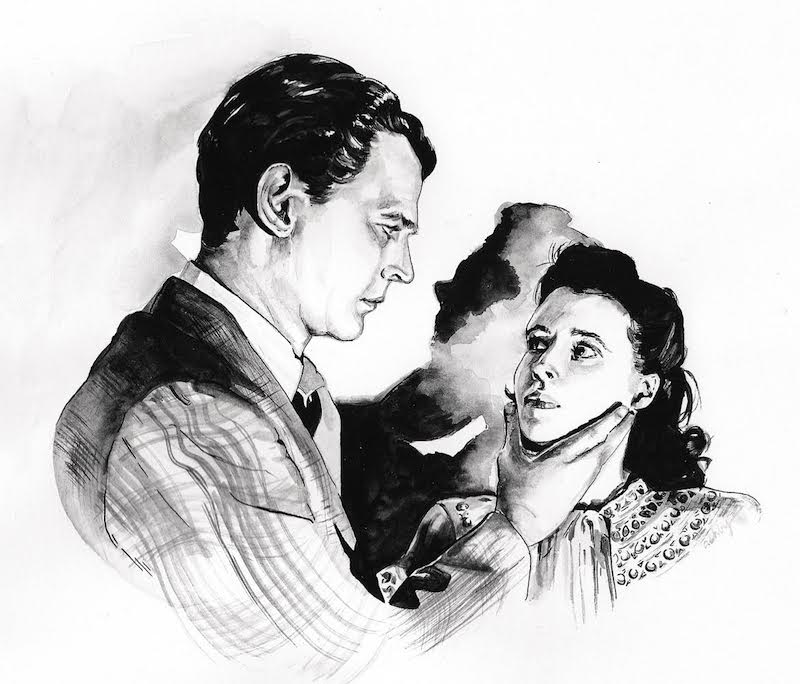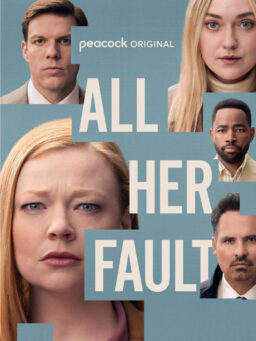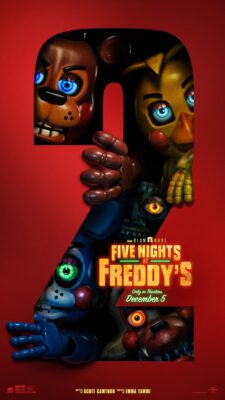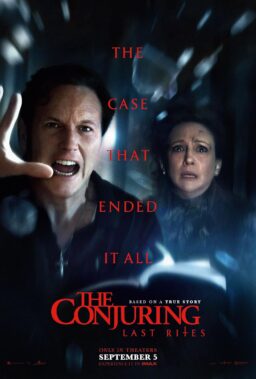Allow us to present our fifth excerpt from the excellent internet
magazine “Bright Wall/Dark Room,” this one by Michael Ryan. The image above is credited to
Brianna Ashby. The theme for the November issue is “Noir”, and in
addition to the “Shadow of a Doubt” essay, the latest issue includes pieces on “The Big Sleep,” “Sudden Fear,” “The Singing Detective,” “The Third Man,” “Brick,” “Southland Tales,” “Night of the Hunter,” “Out of the Past” and an essay on “The 9 Lives of the Femme Fatale.” You can buy the magazine
on your iPhone
and iPad here or sign up for the web-based online version here.
On at least four different occasions, Alfred Hitchcock said that “Shadow of a Doubt” (1943) was his favorite film, but never why. His daughter, Patricia, said it was “because he loved the thought of bringing menace into a small town.” For Hitchcock, part of the game in making his first movie set in America was to make it absolutely American, with a sweet comic surface and a heart as dark as the noirest of the noir. This was his donnee for the film, its generative spark, the “thought” he “loved.” Noir gave Hitchcock a set of conventions to play with– and against. Its thoroughly American origin, atmosphere, and elements he certainly knew thoroughly, its derivation from paint-by-numbers pulp murder mysteries, its hard-boiled loner super-masculine detective and femme fatale and plot that will only end in tears (or a cynical laugh). Hitchcock loved to take such conventions and audience expectations and spin them backwards, to pile irony upon delicious irony, sometimes hilariously, sometimes deeply layered by his singular compositional expertise as a kind of in-joke he enjoyed making for himself and his closest initiates.
To write the script of “Shadow of a Doubt,” Hitchcock hired Thornton Wilder, recent Pulitzer Prize winner for “Our Town,” a play famous for its quintessentially American small-town setting. Instead of the noir city, with its black nights and chiaroscuro lighting, we get a sunlit Santa Rosa with its tree-lined streets and “typical” family, benign comic characters, eccentric neighbors, and even a jolly roly-poly policeman who knows everyone by name and wouldn’t recognize a criminal if he came up and bit him on the nose. The “detective” in “Shadow of a Doubt” is about as opposite as one could be from Sam Spade (or a femme fatale): she’s a teenage girl-next-door just graduated from high school and still living at home. Young Charlie (Teresa Wright) solves the crime, dispatches the villain, and restores the social order—a social order that enables her villainous Uncle Charles (Joseph Cotton) to strangle rich widows and steal their money and never be unmasked. Lest we miss the stark contrast between public appearance and private reality, and the sentimental preservation of the former, Hitchcock drums the irony loudly by ending his movie with Charlie sitting outside the church during Charles’s funeral hearing him lavishly eulogized by a congregation who has no idea who he really was. She sits on the steps with Jack Graham (Macdonald Carey), the actual detective, who now shares her secret. “I’m glad you were able to come, Jack,” she says. “I couldn’t have faced it without someone who knew.” But until the last five minutes of the film, she was alone in her knowledge of the (very) dark truth. Her idolized uncle, whom she was named after, was a brutal psychopathic serial killer, the menace that literally came not only to her small town but into her family’s home. What she has gained in experience, she has lost in innocence, and when the film is over we don’t feel so very warm and fuzzy. Santa Rosa (and small town America) hides nasty stories behind its unlocked but tightly-closed doors.
But the darkest shadow in “Shadow of a Doubt” is the creepy incestuous molestation subtext that haunts the atmosphere from the first scene of Charles and Charlie alone together after his welcome dinner with the family. He follows her into her dimly-lit kitchen and stands very close to her. She says, “We’re not just an uncle and a niece. It’s something else. I know you. I know that you don’t tell people a lot of things. I don’t either. I have the feeling that inside you somewhere, there’s something nobody knows about.”
She’s certainly right about that. We know she’s right in a way she can’t possibly guess at this moment. Her naïve ardent appeal for intimacy is deflected by Uncle Charles. He says, “It’s not good to find out too much, Charlie.” But she insists, “But we’re sort of like twins, don’t you see? We have to know.” Then he says, “Give me your hand, Charlie.” And puts an emerald ring on her finger.
Do we need to guess what happens next? But that’s not what happens. In 2014 maybe it would—not in a 1943 Hollywood movie. Not even a hug or peck on the cheek. That’s not Uncle Charles’s thing. He uses his sex appeal for power and power alone. Not even for money– which he acquires from his serial murders only to dismiss it. What he wants is to be superior to the human race and control everyone, especially women. He is absolutely isolated. He seduces only to conquer— and destroy. His misogynistic dinner-table rant is so over-the top it’s almost funny: “The cities are full of women, middle-aged widows, husbands dead, husbands who’ve spent their lives making fortunes, working and working. Then they die and leave their money to their wives. Their silly wives. And what do the wives do, these useless women? You see them in the hotels, the best hotels, every day by the thousands, drinking the money, eating the money, losing the money at bridge, playing all day and all night, smelling of money. Proud of their jewelry but of nothing else. Horrible, faded, fat, greedy women.”
At this point, Charlie knows Uncle Charles is “the Merry Widow murderer,” and he knows she knows, but he controls her by convincing her that the truth “would destroy her [mother].” So, back to one typical aftermath of incestuous molestation: Charlie keeps their dark secret because to reveal it would destroy the family. Her love of her family and need to protect them puts her life at risk. She doesn’t want Charles to get caught—which also puts her at odds with Jack Graham. If Jack Graham arrests Uncle Charles, the family will find out. All Charlie wants is to get Charles out of town and away from her family forever. (Too bad for the next rich widow he’ll strangle.) But Charles, who doesn’t trust anyone, doesn’t trust her to keep their secret, and tries to cause various fatal “accidents,” the final one—throwing her off the train taking him away from Santa Rosa—ends up killing him instead.
By the time the script was finished, Hitchcock always had his film fully constructed in his mind. In Beyond Doubt: The Making of Hitchcock’s Favorite Film (2000), Teresa Wright said, “I did not read the script. They said, ‘He wants to tell you the script.’ So I went and I sat down opposite him at a desk and he proceeded to tell the story. And he told the story like no one else has ever told a story. He used anything on his desk as a prop, whether it was a glass or a pencil or a book, to make a sound, do sound effects. He’d do steps. He’d do anything he could as a storyteller to lure you into his story. And he told that story so beautifully that I was just absolutely mesmerized. And when I finally saw the film, I said, ‘I’ve seen this film. I saw it in his office.’”
Maybe this explains how Hitchcock meant his infamous outrageous “actors are cattle” remark (which he later jokingly amended to “actors should be treated like cattle”). When an actor questioned Hitchcock’s direction, he’d say, “It’s in the script.” When an actor schooled in the Stanislavski Method wanted to know his motivation, Hitchcock would answer, “Your salary.” He said, “To make a great film you need three things – the script, the script and the script.” The film was finished for Hitchcock when it was written. He claimed the shooting of it didn’t interest him. The shooting consisted only of mechanical solutions to technical problems—of which, of course, he was the master. And of course he’d do anything to get the right shot, spending seven days on the forty-five second and seventy-eight-spliced-pieces-of-film shower scene in “Psycho” and constructing cranes and dollies and elaborate tracking shots for the most precise visual effect, including shots never done before or since. Actors were like pieces of furniture that could move and talk and were no more important to him than how a scene was framed and lit.
That Hitchcock claimed not to value his singular technical expertise clearly doesn’t make it any less essential to the experience and quality of his films. In fact, if you only read the script, the plot-machinery of “Shadow of a Doubt” creaks pretty loudly. The pallid love-story between Charlie and Jack Graham is a shameless plot-function and utterly implausible, not to mention how Jack is able to track Charles to Santa Rosa in the first place when we’re told he has no idea what Charles looks like or who he is— which is itself implausible since somebody must have seen him with one of the many rich widows strangled to death by a suave handsome gentleman who suddenly disappears with their money. But while the movie is playing on the screen, we don’t care and may not even notice. Hitchcock knew all the differences between writing and film, verbal language and visual language, credibility and immediacy. We believe what happens because we see it, because of the way it’s filmed—the composition, the pacing, the camera angles, the soundtrack: the whole experience (especially on the big screen Hitchcock composed for). What matters is what’s on the screen moment to moment. Movies do our imagining for us, and Hitchcock, “the master of suspense,” knew how to focus our attention, to restrict information as well as to present it vividly, and to suspend our disbelief to draw us in completely.
Hitchcock’s characteristic handling of suspense is to withhold information from characters but not the viewer (unlike, say, Agatha Christie): will his main character find out what she needs to know to avert disaster before disaster strikes? We know what she needs to know, but not how and when she will find it out. And this keeps us on the edge of our seats. Or as Hitchcock put it (with his usual mordant wit): “Always make the audience suffer as much as possible.”
Our “suffering” in watching “Shadow of a Doubt” is Charlie’s suffering. The uncle she feels so close to is a monster. She discovers this early in the movie, but she can’t reveal it to anyone, even the handsome young detective who wants to marry her. She is alone with a very smart and highly accomplished murderer trying to kill her. The sweet friendly world of Santa Rosa is itself a threat to her life because its sweetness and friendliness is predicated on not admitting the unsayable truth—the dark shadows of the psyche and human behavior that are the currency of noir and the America that produced (and produces) it.
These shadows are all cast powerfully and dramatically by Uncle Charles. His shadow falls over Charlie wherever she goes. He is a man of the lie. His soul is lost in the lie. Were he not insulated by his compulsion and his self-justifying belief in his superiority, he’d suffer the unremitting isolation of protecting a secret that needs to be hidden from everyone on earth, even the people who love him. But he is insulated, and he’s too arrogant to suffer from his evil crimes. He loves no one, nor can he feel loved because he knows no one knows him. And he is right. Charlie hates him when she finds out who he is. But he doesn’t care. He sees her only as a threat that must be eliminated. He is one of cinema’s great psychopaths. The only person who suffers in the film is Charlie.
That she is Charles’s collaborator in keeping his murderous secret is the ultimate excruciating twist Hitchcock and his collaborators layered into the script. What a brilliant piece of screenwriting it is. After Wilder enlisted and left for the war, Hitchcock hired Sally Benson, a New Yorker writer of humorous small town nostalgia, to help him and his wife Alma to polish the jokes. They made Charlie’s father a crime magazine buff who competes with his friend Herb in making up perfect murders of the most grisly variety. (They are noir script writers, too.) They ironically mirror not only Charles in the movie but also Hitchcock and his collaborators writing the movie.
And, Hitchcock’s opinion of actors notwithstanding, Joseph Cotton and Teresa Wright gave their career performances in “Shadow of a Doubt.” Cotton was 38 and Wright was 25 (and not the teenage girl-next-door). They were later cast as husband-and-wife in “The Steel Trap,” a 1952 film noir, so at least one director after Hitchcock made explicitly conjugal what in Hitchcock’s film is forbidden and repugnant.
When asked by critics to name the overarching theme for “Shadow of a Doubt” Hitchcock responded: “Love and good order is no defense against evil.” Brutally accurate, except that’s not quite the film he made. It would be the film he made if Charles had successfully pushed Charlie off the train and had not slipped and fallen himself. And away the train would chuff, into the distance, spuming black smoke. Hitchcock would have made a film noir. As it is, he gets it both ways: the heart of darkness and the uplifting human capacity to bear the unbearable when it’s shared with another human being. In other words, what art can do and “Shadow of a Doubt” does: it makes a shape for isolating pain that does not make the pain less painful but allows it to be communicated. Even if we don’t know how it feels to be a teenage girl hunted by a psychopath living in her own room in her own house while being unable to tell anyone else about it, we know what it’s like to be alone, and we hope for love and connection to others that not only admits but invites the truth.











